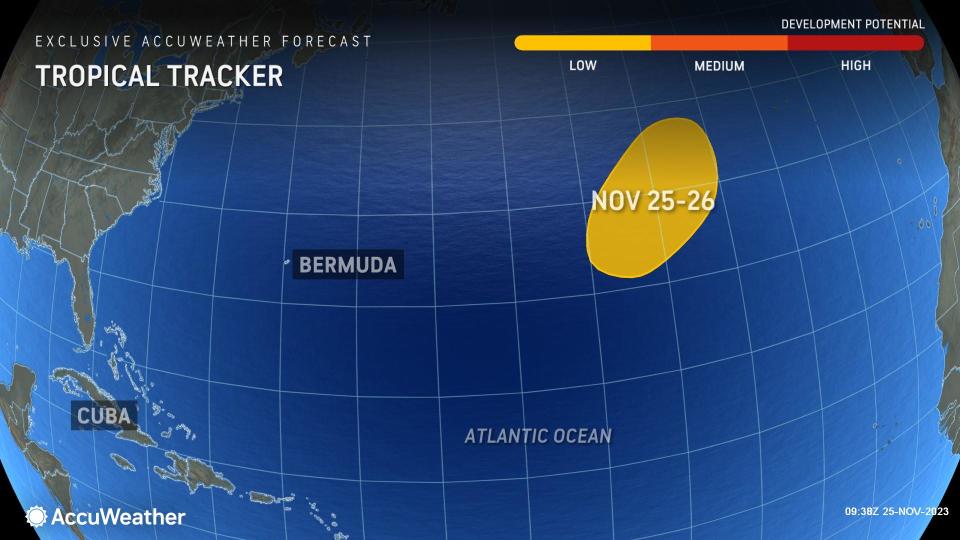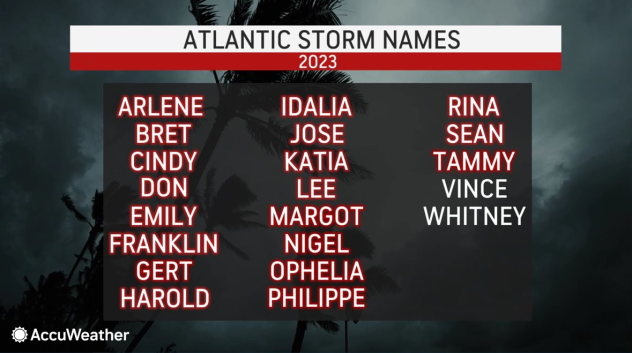Will a new Atlantic storm form as the end of hurricane season nears?
The 2023 Atlantic hurricane season runs through Nov. 30, and AccuWeather meteorologists say that there is a low chance for a storm to form in the central part of the basin prior to the season's official end. Regardless, the season will close out with a higher number of named storms compared to the historical average.
The zone where tropical development is most likely into early next week is to the southwest of the Azores in the open Atlantic Ocean.
 |
Should an area of low pressure organize and produce maximum sustained winds of at least 39 mph, it would be classified as a tropical or subtropical storm and acquire the name Vince. A subtropical storm has both tropical and non-tropical characteristics.
 |
This system, regardless of whether it has developed tropically, could eventually approach the Azores late this weekend or early next week, according to AccuWeather Meteorologist Adam Douty. A close pass to the islands would bring an uptick in downpours and perhaps gusty winds, depending on the strength of the system.
Given the trajectory of the system, AccuWeather does not expect it to approach the United States.
As the official end of the hurricane season quickly approaches, AccuWeather meteorologists are taking a look back on the year thus far and comparing how it has stacked up to the historical average, as well as pre-season predictions.
"Overall, AccuWeather's 2023 Atlantic Basin Hurricane Forecast which was issued in March, over a month ahead of many other sources, worked out well," AccuWeather Tropical Meteorologist Alex DaSilva explained.
AccuWeather's initial forecast predicted four to eight hurricanes, one to three major hurricanes and two to four direct impacts to the United States. As of Nov. 22, the Atlantic basin has spawned seven hurricanes and three major hurricanes, which are both on par with the 30-year historical average.
Four storms brought direct impacts to the United States, including three landfalling systems. Tropical Storm Harold was the first to strike, making landfall on Padre Island, Texas, on Aug. 22. The strongest storm to make landfall in the U.S. this season, Idalia, crashed ashore in Florida as a powerful Category 4 hurricane one week later. Tropical Storm Ophelia was the third and final tropical system to directly strike the contiguous U.S., making landfall in North Carolina on Sept. 22.
Hurricane Lee made a close brush to the U.S. with some direct impacts being felt along the coast of New England, but the storm ultimately made landfall in Nova Scotia on Sept. 16.
 |
In early November, AccuWeather correctly predicted that there would be no more direct U.S. impacts from a tropical system throughout the remainder of the 2023 Atlantic hurricane season.
"[This year] was a special case as the season started with an unnamed tropical storm back in January, and as a result we saw 20 total storms and 19 named storms," DaSilva said. He added that this number would increase if tropical development occurs in the coming days. On average, there are 14 named storms in a season.
The above-average number of named storms has also coincided with an above-average Accumulated Cyclone Energy (ACE). The season's ACE value is a metric that meteorologists use to track the intensity and longevity of tropical systems.
As of Nov. 23, the ACE for the 2023 season was 145.6, above the historical average of 122.5, according to Colorado State University. It is also higher than last season, which finished with an ACE of 95.1.
Want next-level safety, ad-free? Unlock advanced, hyperlocal severe weather alerts when you subscribe to Premium+ on the AccuWeather app. AccuWeather Alerts™ are prompted by our expert meteorologists who monitor and analyze dangerous weather risks 24/7 to keep you and your family safer.






